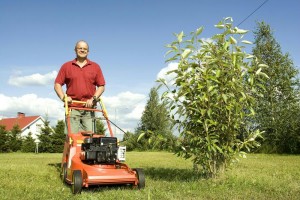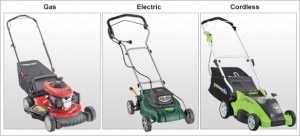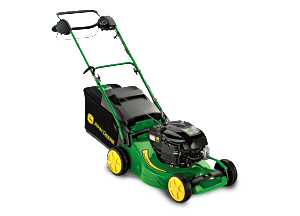 We decided to post the general Lawnmower General Operation that are found in many lawnmower manuals as a handy reference for our readers. The following is a long list of guidelines, that everyone should read at least once before operating a lawnmower for the first time. It is also a good refresher for anyone who is purchasing a new lawnmower and may want to brush up on operating guidelines.
We decided to post the general Lawnmower General Operation that are found in many lawnmower manuals as a handy reference for our readers. The following is a long list of guidelines, that everyone should read at least once before operating a lawnmower for the first time. It is also a good refresher for anyone who is purchasing a new lawnmower and may want to brush up on operating guidelines.
Lawnmower General Operation – Read the Manual
Read the operator’s manual carefully in its entirety before attempting to assemble your lawnmower. Read, understand, and follow all instructions on the machine and in the manual before operation. Keep this manual in a safe place for future and regular reference and for ordering replacement parts.
Be completely familiar with the controls in the proper use of this machine before operating it.
Your lawn mower machine is a precise piece of equipment and not a plaything. Therefore, exercise extreme caution at all times. Your lawnmower has been designed to perform one job: to mow the grass. Do not use it for any other purpose.
Lawnmower General Operation – Safety
Never allow children under 14 years old to operate your lawnmower. Children 14 years old and older should read and understand the instructions in this manual and should be trained and supervised by an adult.
Only responsible individuals who are familiar with these rules of safe operation should be allowed to use this machine.
Thoroughly inspect the area where the equipment is to be used. Remove all stones, sticks, wire, bones, toys, and other foreign objects which could be tripped over or picked up and thrown by the lawnmower’s blade. Thrown objects can cause serious personal injury.
Avoid discharge of material toward buildings, sidewalks, bystanders, and the like to avoid accidents. Also, avoid disturbing material against a wall or obstruction which may cause discharged material to ricochet back toward the operator.
Keep Bystanders Away
To assist in avoiding blade contact and thrown object injury, stay in the operator’s position behind the handles and keep children, bystanders, helpers at least 75 feet from the mower while it is in operation. Stop machine if anyone enters the area.
Always wear safety glasses or safety goggles during operation and while performing an adjustment or repair to protect your eyes. Objects which ricochet can cause serious injury to the eyes.
Where sturdy rough soled work shoes and close-fitting slacks and shirts. Shirts and pants that cover the arms and legs and steel toe shoes are recommended. Never operate this machine in bare feet, sandals, slippery or lightweight shoes.
Do not put hands or feet near rotating parts or under the cutting deck. Contact with the blade can amputate hands and feet.
A missing or damaged discharge cover should be in place to avoid blade contact or thrown object injuries.
Many injuries occur as a result of the lawnmower being pulled over the foot during falls caused by slipping or tripping. Do not hold onto the handle of the lawnmower if you are falling; release the handle immediately.
More Safety Suggestions
Never pull the lawnmower backward towards you while you are walking. If you must back the mower away from the wall or obstruction first look down and behind you to avoid tripping and then follow these steps:
- step back from the mower to fully extend your arms
- be sure you are well balanced and surefooted
- pull the lawnmower back, no more than halfway toward you
- repeat these steps as needed
Do not operate the lawnmower while under the influence of alcohol or drugs.
Do not engage the self-propelled mechanism on units so equipped while starting the engine
The control handle is a safety device. Never attempt to bypass its operation. Doing so makes a safety device inoperative and may result in personal injury through contact with the rotating blade. The control handle must operate easily in both directions and automatically return to the disengage position when released.
Do not operate the lawnmower in wet grass. Always be sure of your footing. A slip and fall can cause serious personal injury. If you feel you are losing your footing, release the control handle immediately and the blade will stop rotating within 3 seconds.
Mow only in daylight. Walk never run
Stop the blade when crossing gravel drives, walks, or roads.
If the equipment should start to vibrate abnormally, stop the engine and check immediately for the cause. Vibration is generally a warning of trouble.
Safety Always Comes First
Shut the engine off and wait until the blade comes to a complete stop before removing the grass catcher or unclogging the chute. The cutting blade continues to rotate for a few seconds after the engine is shut off. Never place any part of the body in the blade area. Make sure that the blade and engine have come to a complete stop.
Never operate the lawn mower without a proper trail shield, discharge cover, grass catcher, blade control handle or other safety protective devices in place and working. Never operate a lawnmower with damaged safety devices. Failure to do so can result in personal injury.
Muffler and the engine become hot and can cause burns. Do not touch.
Only use parts and accessories made for your machine by the manufacturer. Failure to do so can result in personal injury.
Pull cord slowly until resistance is felt. Then pull rapidly. Rapid retraction of starter cord will pull hand and arm toward the engine faster than you can let go. Broken bones, fractures, bruises or strains could result.
Call customer assistance for the name of your nearest servicing dealer.
Read your own lawnmower guide for specific instructions related to your lawnmower.
Save
 Most gardeners realize the importance of a hose. Improper use or a hose of poor quality can be annoying and harmful. Does your hose have leaky connections? Is it too short? Is it impossible to roll up? Are the edges of its metal couplings sharp and jagged? Garden hose buying tips should take these factors into account.
Most gardeners realize the importance of a hose. Improper use or a hose of poor quality can be annoying and harmful. Does your hose have leaky connections? Is it too short? Is it impossible to roll up? Are the edges of its metal couplings sharp and jagged? Garden hose buying tips should take these factors into account.










